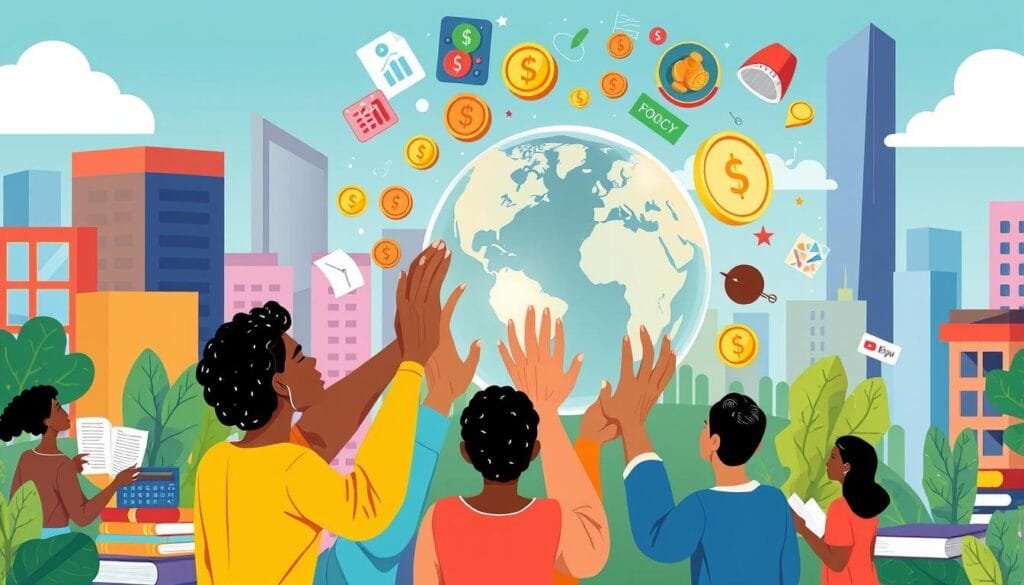Ever thought about how a nation’s wealth affects its people’s literacy and life? It’s a topic worth exploring. Our guide delves into how economic health impacts financial literacy and overall societal well-being.
National wealth is more than GDP numbers. It includes education, healthcare, and living standards too. Understanding these aspects is crucial for a better future.
We’re diving into important areas, including financial literacy. Nowadays, most states teach personal finance in schools. This education is especially vital for disadvantaged students. It helps with wise decisions and keeps the economy stable.
Key Takeaways
- National wealth reflects both quantitative (GDP) and qualitative (education, healthcare) factors.
- 45 states include personal finance in their education standards; 24 require it for high school students.
- Financial literacy has been proven to positively impact economic behavior and decision-making.
- Economic stability is closely linked to a population’s financial literacy levels.
- Increased financial education could potentially enhance national wealth and individual quality of life.
Understanding National Wealth: Key Indicators and Measures
National wealth combines many economic indicators. These show the health and wealth of a country. Let’s look at three key measures: GDP and its elements, the impact of natural resources, and how human capital and innovation matter.
GDP and Its Components
GDP measures a country’s economic output. It totals the market value of all goods and services made within a country. It helps the White House and Congress make budget plans. It also guides the Federal Reserve in setting monetary policy. GDP includes consumption, investment, government spending, and net exports.
Each part of GDP tells us about the economy’s flow. Consumption shows what households buy. Investment reflects business spending on things like factories. Government spending covers public services. Net exports calculate exports minus imports. Together, these parts give a full view of economic health.
The Role of Natural Resources
Natural resources boost a nation’s wealth. Countries with lots of oil, gas, minerals, or fertile earth can use these for growth. These resources also help with trade and earn money. It’s crucial to manage these wisely for the economy and the environment.
Human Capital and Innovation
Human capital is also crucial. It includes the workforce’s education, skills, and efficiency. The Bureau of Economic Analysis says innovation drives the economy. Skilled workers and new ideas keep a country competitive. Spending on education and training is essential.
To sum up, national wealth assessment is complex. It includes GDP details, natural resources, and human capital with innovation. These factors show how a country can grow economically and sustainably.
Economic Strength: Indicators and Influencing Factors
To understand a country’s economic health, we look at different key measures. We will explore essential parts of economic stability, the importance of trade balance, and how investing in infrastructure matters.
Macroeconomic Stability
The foundation of a strong economy is its macroeconomic stability. We measure this with key indicators. For example, our unemployment rate was 4.1% in September 2024. Our inflation followed at 2.4%.
Consumer spending is also big, making up about 68% of the U.S. GDP by the second quarter of 2024. This highlights how vital stability is for growth.
The Federal Reserve aims for a 2% inflation rate to keep prices stable. This helps create a steady economic setting. Tools like the Consumer Price Index (CPI) and Gross Domestic Product (GDP) are key to watch this.
Trade Balance and Export Strength
A strong trade balance supports economic strength. It helps our economy grow, especially through exports. The U.S. gains a lot from exporting a variety of manufactured products. This improves industrial production and creates jobs.
Trade reports every month show these trends, which helps us see the big economic picture. They guide policymakers and investors on where to use resources.
Investment in Infrastructure and Technology
Putting money into infrastructure is key for economic growth over time. Spending in construction, which includes labor and materials, boosts stability. Reports every month give us insights on these investments.
Putting money into technology is just as important. It makes industries modern and competitive. Technology drives innovation, makes operations smooth, and boosts the economy. Together, these investments build a strong economic base.
| Macroeconomic Indicators | Current Data | Impact |
|---|---|---|
| Unemployment Rate | 4.1% (Sep 2024) | Low unemployment suggests economic stability |
| Inflation Rate | 2.4% (Sep 2024) | Controlled inflation indicates stable purchasing power |
| Consumer Spending | 68% of GDP (Q2 2024) | High consumer spending drives GDP growth |
| Construction Spending | Monthly National Reports | Reflects economic activity and infrastructure development |
Financial Literacy: Basics and Importance in Modern Societies
Today’s economy is changing fast. It’s really important to know the basics of managing money. This helps people make smart decisions, keep their finances stable, and helps the economy too.
It’s surprising, but only seven states in the U.S. require high school students to take personal finance courses. This shows a big gap in our education system. Many adults in America feel they lack important money skills. This was found in a study by the Financial Industry Regulatory Authority (FINRA). We need to make sure financial education is part of all schools.

Knowing about money matters helps people manage their budget and debts. It also helps understand credit scores. Being smart about finances means you’re less likely to get scammed and can better plan for emergencies and retirement.
Learning about money is also key for the development of communities and economies. Financial education, like debt management, can be designed for different ages. For example, the Commercial Bank of California (CBC) works with places like California State University Fullerton and Samueli Academy. They make sure finance lessons are part of school.
Parents also have a big role. Schools have special events about money basics for families. This helps teach kids early on and builds a strong base for them at home. Teaching everyone these skills is good for everyone’s financial health.
| Financial Insight | Statistics |
|---|---|
| Americans living paycheck to paycheck | 78% |
| Adults worldwide with minimum financial literacy | 38% |
| Total student loan debt in the U.S. | $1.5 Trillion |
| Ownership of credit cards in America | 189 Million |
| Average number of credit cards per person | 4 |
| Total U.S. debt | $12.58 Trillion |
| Credit card debt in the U.S. | $1.04 Trillion |
Understanding money basics lowers stress and builds important skills like good communication and thinking critically. When society knows about money, it leads to better economic policies. It encourages active economic participation, like paying taxes and supporting local shops. This makes the future more stable and strong for everyone.
Factors Contribiting to National Wealth
It’s important to know what makes a nation wealthy. We look at how education, government policies, and the business setting play their parts. The impact of education on wealth, government’s role, and business environments are key.
Educational Attainment
Education boosts productivity and innovation, affecting wealth. In Chile, people often study up to grade 10.4. Yet, only half know the basics of finance. This shows the urgent need to invest more in learning. A lack of education leads to less wealth, highlighting how crucial education’s effect on wealth is.

Government Policies
Government actions greatly shape a nation’s economic health. Chile’s example of requiring 10% of salaries for pensions shows this. Such laws help build wealth. Experts like Annamaria Lusardi and Olivia S. Mitchell found that teaching financial skills helps with saving for retirement. This proves how big a role government policy plays in creating wealth.
Business Environment
A good setting for business is crucial for wealth. Adam Smith and Max Weber both said a healthy business environment is key. Weber believed in the importance of organized bureaucracies for wealth. These opinions show how vital a strong business climate is for economic health.
How Economic Strength Affects National Wealth and Literacy
A strong economy is key to a country’s wealth and how many people can read and write. With more money, countries can improve schools and health care. This helps society grow in many ways.

Impact on Education Systems
Money plays a big role in how good a country’s schools are. In rich countries, schools have great buildings, teachers, and resources. This is because these places have more money to spend.
When more workers have gone to school, an economy does better. They can do their jobs better and quicker. This makes their countries stand out in the world. So, good schools lead to more money and growth in a country.
| Indicator | Low Income Countries (LIC) | High Income Countries (HIC) |
|---|---|---|
| Gross National Income (GNI) per capita | $1,035 or less | $12,535 or more |
| Literacy Rate | Lower | Very High (nearly universal) |
| Enrollment Ratio | Lower | Significantly Higher |
Correlation with Health and Social Services
How rich a country is also affects its health care. Countries with more money can give better health services. This means people live longer and healthier lives.
For example, people in France live longer than those in the U.S., even though France is less wealthy. This shows that spending on health care matters a lot. Also, countries getting richer see fewer babies die and people live longer.
In closing, a strong economy helps education and health care. Making sure money goes to these areas is crucial. It leads to more wealth and better ability to read and write for everyone.
Strategies to Enhance Financial Literacy Among Citizens
The financial world is getting more complex. It’s important to focus on improving financial literacy for everyone. Only about 30% of adults know the basics of finance well, showing a big knowledge gap. With the right financial education strategies, we can fill this gap and help people make smarter money decisions.
Teaching finance in schools from a young age is key. Many millennials struggle with basic finance concepts like interest rates. Introducing financial education early on helps build a strong base, preparing young people for future financial decisions.
Community programs are also vital for teaching adults about finance. Workshops and seminars offer practical knowledge that can improve how people handle money. For example, attending financial literacy programs can lead to a 15% increase in net worth within five years.
Using technology and media is another powerful tool. Platforms like social media, newsletters, and podcasts are great for spreading financial knowledge. A Forbes Advisor survey in 2023 found that 79% of young adults use social media for financial tips. These channels can really broaden our reach and impact.
Adult learning programs are crucial too. Households earning over $100,000 a year know more about finance than those with less income. By making adult learning accessible, we can lessen this difference. These programs should help specific groups, like low-income families and the elderly, with targeted financial lessons.
| Group | Financial Literacy Level | Impact of Education |
|---|---|---|
| Adults | 30% can answer basic questions | 15% net worth increase with training |
| Millennials | 40% struggle with interest and inflation questions | Significant improvement with early education |
| Low-Income Households | 30% lower literacy rates | Immediate benefits from tailored programs |
Adding financial education in workplaces can also make a big difference. For example, these programs have increased participation in company retirement plans by 25%.
By using these strategies, we can boost financial literacy for all. This leads to better decisions and financial health for everyone.
What Is the National Wealth/Economics Strength and Literacy?
National wealth goes beyond just money. In 1776, Adam Smith introduced important ideas in “The Wealth of Nations.” He talked about the importance of self-interest, limited government, and strong currency for success. These ideas are still important when we talk about how money and policies work today.
Economic strength means looking at many things, like how stable the economy is, trade, and spending on important projects. Smith introduced the “invisible hand” idea. It says when people seek their own gain, they also help society. This concept helps us see how money strength and knowing how to read and manage money are linked. Both are needed for a good society.
Being able to read well and understand money is key for the economy to grow well. But, studies show students across the country don’t do well in understanding money, with scores below 60%. This issue, along with high bankruptcy rates and too much information for consumers, shows we need big changes in education.
Let’s check some important facts to better understand national wealth, economic strength, and their connection to reading and understanding money:
| Concept | Data/Observation |
|---|---|
| The Wealth of Nations | Published in 1776 |
| Mercantilism | Led to retaliatory tariffs restricting international trade |
| Gas Shortages (1970s) | Price controls led to long lines at gas stations |
| Tariffs | Example: Scottish wine 30 times more expensive than French wine |
| Students’ Financial Literacy | Score consistently below 60% |
| Bankruptcy Rates | Highest levels in history |
| Global Cost of Illiteracy | $1.2 trillion |
| Literacy and Infant Mortality | Higher literacy rates correlate with lower infant mortality rates |
| Word Gap Between Income Levels | 30 million word gap by age 4 between low-income and higher-income families |
The facts show us the deep impact that knowledge and policies have on being able to read and understand money. Smith’s approach makes us think about the bigger picture. It shows how economic decisions affect everyone’s life. By learning more about economics and improving education, we aim for a society that is both smart and financially stable.
Conclusion
As our discussion comes to an end, let’s reflect on the connection between national wealth, economic power, and the role of literacy. We’ve seen how these factors together shape a country’s future. Our journey through this topic shows that national wealth isn’t just about GDP. It’s also about resources, people’s skills, and new ideas leading to growth.
Economic strength connects with financial stability, trade, and investing in key areas like infrastructure and tech. The insights we’ve shared show that a strong economy leads to higher productivity and a better life. The changing global economy, shaped by new consumer behaviors, financial understanding, and tech, plays a big role.
Looking at the role of literacy, it’s clear it links closely with a nation’s wealth and economic might. Education is the foundation of prosperous societies. Improving financial literacy can bring big economic rewards. The data on global school enrollment, the impact of COVID-19, and education gaps stress the need for ongoing work in education.
In conclusion, supporting the key areas of national wealth, economic strength, and literacy needs work from all sides. Policymakers, schools, and companies must work together. Focusing on these areas together is key to ensuring a bright future for future generations.
FAQ
What are the key indicators used to measure national wealth?
A: Gross Domestic Product (GDP), natural resource value, human capital, and innovation levels are key indicators. They show how wealthy and economically healthy a nation is.
How is GDP composed and why is it significant?
GDP includes consumption, investment, government spending, and net exports. It’s important as it measures a nation’s economic activity and health.
What role do natural resources play in economic strength?
Natural resources are important assets. They add to GDP and support industries like mining and agriculture. This boosts the economy.
Why is human capital and innovation important for a nation’s wealth?
Human capital and innovation grow the economy. They do this by improving productivity and creating new industries. Education and R&D investment are key.
How do macroeconomic stability indicators impact a country’s economic strength?
Indicators like inflation and employment rates influence economic strength. They do this by affecting investor confidence and keeping the economy stable. Stable economies attract investments and grow sustainably.
What is the significance of a trade balance and export strength?
Trade balance and export strength show a nation’s global market success. A positive trade balance means the economy is strong and competitive.
How do investments in infrastructure and technology contribute to economic strength?
These investments boost productivity and innovation. They’re crucial for a modern, efficient economy. This supports business growth and improves living standards.
Why is financial literacy important in modern societies?
Financial literacy helps people make smart money decisions and manage finances well. It leads to economic stability. It prepares citizens to face economic challenges.
What factors contribute to a nation’s wealth in the long term?
Education, effective policies, and a good business environment contribute. They build a skilled workforce and encourage innovation. This creates a strong economy.
How does economic strength affect national education systems?
A strong economy improves education systems. It funds resources, infrastructure, and programs. This leads to a skilled workforce.
What is the correlation between economic strength and health, and social services?
Economic strength supports health and social services. This improves public health and societal well-being. Governments can then invest in healthcare and safety nets.
What strategies can enhance financial literacy among citizens?
To improve financial literacy, include it in school curricula, offer workshops, use online resources, and promote good money management. These help citizens make informed financial choices.
What is meant by national wealth, economic strength, and literacy interconnectedness?
These three elements help a country prosper and improve quality of life. A strong economy supports a good education system. This produces a skilled, literate population that boosts the economy even more.
